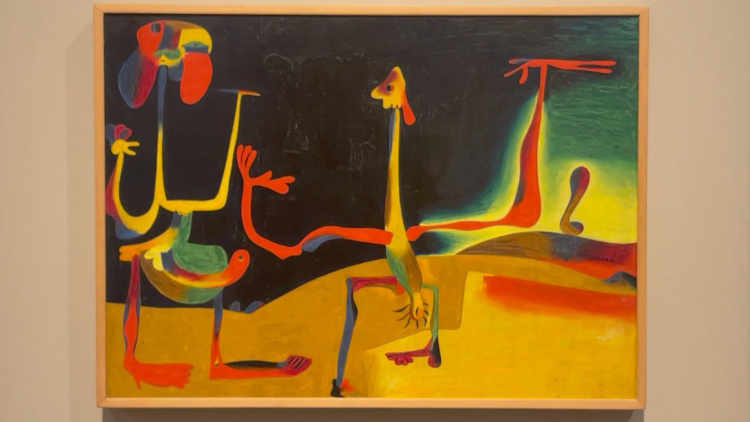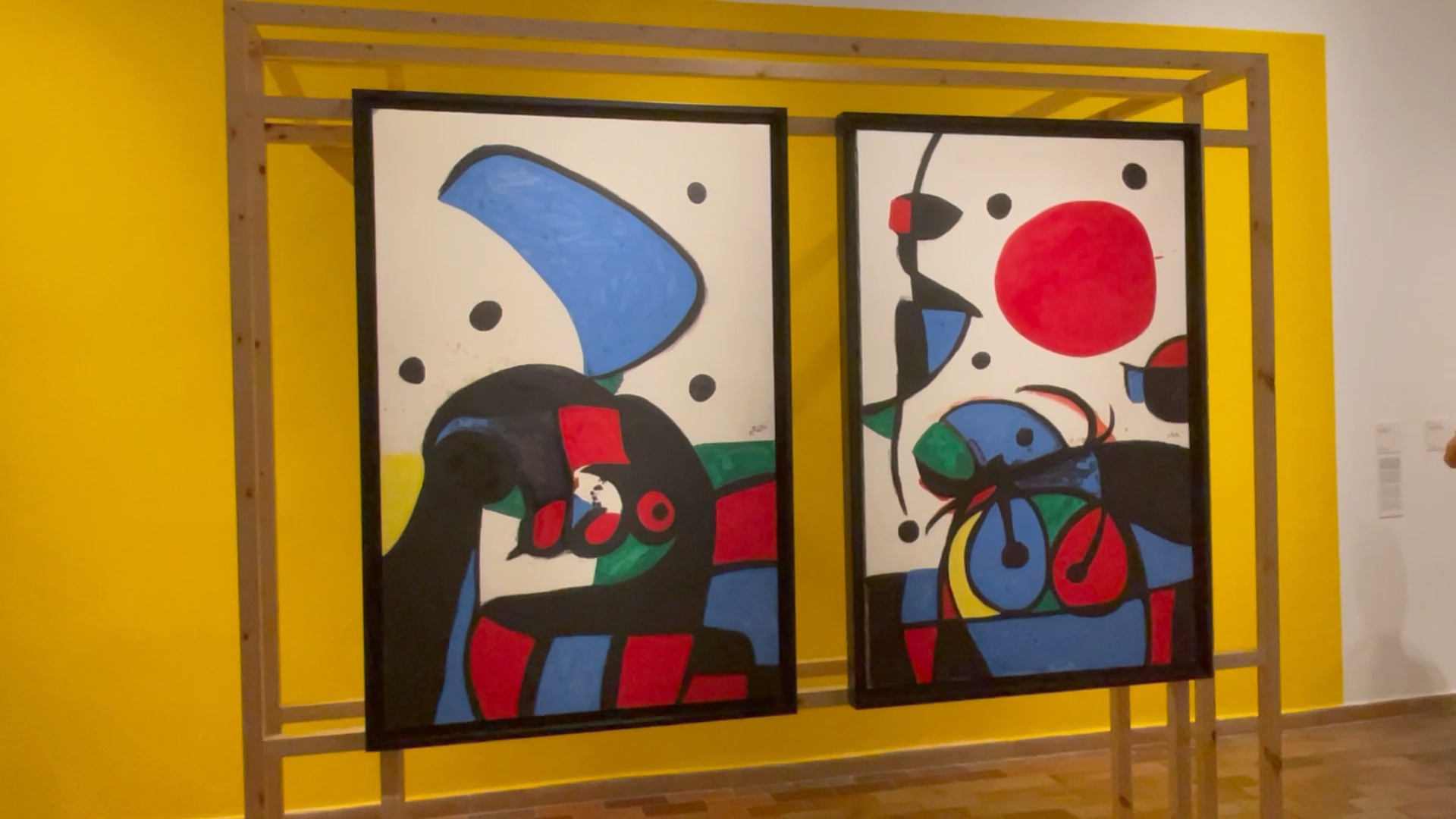Joan Miró: evocative icon, 'surrealist before surrealism', and proud Catalan
One of the most unique artists of the 20th century, Miró lived through turbulent times that would mark his work with both beauty and grotesqueness

Joan Miró is one of the most iconic artists ever to emerge from Catalonia.
Even if you think you don’t know him, there’s a decent chance you’ve at least come into some contact with his work, especially if you’ve ever been to Barcelona. A mural of his is painted outside the airport walls, while he also has a mosaic in the middle of the La Rambla boulevard.
Have a listen to our Filling the Sink podcast to learn more about Miró:
Primarily a painter but also well known for his sculpture, Miró’s unique, colourful, expressionistic style has transcended the art world, leading him to be one of the most universally recognised and respected figures of the 20th century.
Marko Daniel, director of the Miró Foundation in Barcelona, believes that many more people are familiar with the “iconic paintings and images” of the artist than they may realise. He was one of the “foremost painters of the last century” who worked until the 1970s, and produced many works based on the Catalan landscape and nature, “but then very quickly went into exploring a more surreal world, a world of imagination.”
Miró, the 'surrealist before surrealism'
Andre Breton, the father of the surrealist art movement in the early 20th century, once dubbed Miró a ‘surrealist before surrealism.’ However, Miró totally rejected labels such as that throughout his career.
“[Joan Miró] developed his own style, which is really unique and instantly recognizable, independently of the surrealist movement, and the surrealists saw an affinity between the way in which Miró was working and the way in which they were conceiving of the world and of art,” Daniel explained to Catalan News. “Very quickly his art became so experimental, so groundbreaking, that these labels didn’t make any sense.”

Miró sought to connect with his subconscious through his painting, creating some of his works in a near dreamlike state of semi-consciousness. The results were intriguing arrangements of abstract shapes, lines, and colors that depicted the artist’s very soul that have gone on to become emblematic of his work.
In certain pieces, such as The Farm, which celebrates its centenary in 2022, the level of detail is awe-inspiring, another style of painting that Miró enjoyed. The Farm also drew on themes of landscape and countryside, which the artist would repeatedly return to.
“The ladder, for him, is this really miraculous instrument,” Marko Daniel explains. The image of the ladder, alluding to a yearning to escape, appears repeatedly in Miró’s paintings. “It’s such a simple thing: two verticals and the horizontal stripes, but for him, it connects the earth with the heavens, with the firmament, with the stars, with the universe.”
The Miró triangle
The concept of the Miró triangle is a “really important aspect in his work,” Daniel says. The triangle connects three places in the world integral to his paintings: Barcelona, the city where he was born, Mallorca, where he lived with his wife Pilar for many years, and Mont-roig del Camp, where his family had a farmhouse and where he spent a lot of time in his most formative years.
In 1911, Miró’s parents bought a farmhouse in southern Catalonia, Mont-roig del Camp, in a scenic agricultural part of the country.
“From [Mont-roig del Camp], Miró wrote a really beautiful and striking letter to his parents in which he set out that he wanted to dedicate himself to painting,” Marko Daniel explains. “He said he wanted to abandon his previous life – his parents had obliged him to train as an accountant – and he said in this letter, very formally, ‘I beseech you that I need to abandon my former life and dedicate myself to painting, for which I was born’.”
It was a clear declaration of intent that was made in Mont-roig, an area of the world that would serve as inspiration to many of Miró’s landscape works. As the director of the Miró Foundation puts it: “It was in Mont-roig that he really developed this contact with nature, with the tilled fields, but also with the beach, the sea, the Mediterranean sky.”
Wartime
Born in 1893, Miró came of age at a time when Europe was an extremely turbulent place. The events of the 20th century profoundly impacted his work and shaped him as a person. He lived through the brutality of the Spanish civil war and the Franco dictatorship that followed, and witnessed the horrors of the second world war across the continent.
“All his art expressed horror at war in general, and particularly resistance against Franco,” Daniel explains. Miró fled Spain for the north of France during the civil war, but when World War Two began, he went back the other way.
“While hundreds of thousands of refugees tried to cross the border from Spain into France where they ended up in refugee camps, he went the opposite way.”

He moved to Mallorca during this time, after being “smuggled back into Spain under the cover of night thanks to some help from some friends,” Marko Daniel recounts. Here, he was more so known for being his wife’s husband – “Pilar’s bloke” as Daniel puts it – as nobody on the island knew who he was. Here, he blended into the background of this boring, middle-class family life – exactly what he needed at the time.
The grotesque and brutal nature of war and these conflicts made their way to Miró’s artworks. ‘Still Life with Old Shoe’ is one striking example of the horrors of violence seen in a Miró painting, taking everyday objects and giving them a hideous twist with psychedelic and acidy colors that would not be commonly seen in popular culture for decades.
Joan Miró often worked in series, creating numerous works under a certain theme. The Barcelona series, for example – 50 works made in a frenzy of creativity in a lithographer’s studio – depicted figures that relayed the sentiment of the post-war period, through the artist’s eyes.
These figures were “contorted, twisted, … angry, violent, and suffering,” Daniel says. “I think in these works, one can see that everyone, the aggressors and the victims, are in a bad place.”
Political works
Perhaps naturally occurring as part of his personality, or perhaps influenced by the events of the world during his life, Miró was a deliberately political artist.
At the 1937 International Paris Exposition, he and Pablo Picasso represented the Spanish second republic, at the time in the midst of the civil war with Franco’s nationalists. Here, Picasso displayed his seminal ‘Guernica’, depicting the atrocious bombing campaign in the Basque Country, while Miró displayed ‘The Reaper’ – a title laden with symbolism of the Catalan national anthem.
‘The Reaper’ (‘El segador’) shows a farmer wearing a traditional Catalan hat and holding a sickle in one hand, quite an explicit political image, made in defiance of Franco’s fascist coup d’etat happening at the time. This work would eventually be lost to mystery – after the 1937 expo, nobody is quite sure whether it was stolen or destroyed, but it hasn’t been seen since.
Later in his career, Miró created some works for Catalan institutions at a time when the Catalan language and culture was suppressed under the dictatorship. He designed a poster for pro-independence civic group Òmnium Cultural which asked citizens, ‘Are you helping Catalan culture?’

In 1968, he created a poster for a campaign led by the book publishers Editorial Salvat. Overnight, Barcelona was plastered with these posters promoting the first encyclopaedic dictionary in Catalan. The campaign also included a play on words, as ‘Salvat Català’ could be read as meaning “save yourself, Catalan,” while ‘Salvat’ is also a Catalan surname, from which the publishers got its name.
That same year, for May day, he designed the poster for a demonstration called by the trade union CCOO. In 1968, workers’ rights and the labor movement as a while was still heavily suppressed by the regime, yet Miró still stuck by his principles in the face of Franco.
FC Barcelona, described by Manuel Vázquez Montalbán as the “unarmed army of Catalonia,” celebrated their 75th anniversary in 1974 with a poster specially designed by Joan Miró.
“It was also very important for him to be Catalan, not Spanish,” Daniel says. “He always insisted that his name was ‘Joan’ Miró, not ‘Juan’, the Spanish version of his name.”
Miró was one of the foremost artists of the 20th century and one of the most brilliant minds to come from Catalonia perhaps ever. From the beauty of his constellation series to the grittiness of his anti-war creations, Miró managed to touch the hearts of millions in many different ways through his work, ensuring his legacy will be remembered forever.